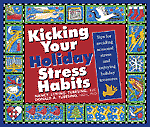 Kicking Your Holiday Stress Habits, taken from the book of the same name by Donald A. Tubesing and Nancy Loving Tubesing.
Kicking Your Holiday Stress Habits, taken from the book of the same name by Donald A. Tubesing and Nancy Loving Tubesing.
Holidays offer opportunities for personal reflection, participating in tradition, gathering with family, connecting with friends, gift-giving, spiritual renewal—all potential sources of joy and satisfaction. However, whether you’re celebrating Thanksgiving, St. Nicholas Eve, Kwanza, Winter Solstice, Navidades, Hanukkah, Christmas, St. Lucia Day, Boxing Day, or New Year’s Eve, holidays are intrinsically stressful.
- Is your holiday season filled with “shoulds” that don’t bring the fulfillment you yearn for?
- Do you feel guilty when it seems that others are enjoying the holidays more than you?
- Do you find yourself over-indulging, over-scheduling, over-spending, and still not feeling satisfied?
- Do you end the holidays feeling more empty than you did at the beginning?
If you said yes to any of the above questions you’re probably trapped in some negative holiday stress habits.
Family tensions, overcrowded social schedules, painful memories of lost loved ones, an endless list of tasks to accomplish, and unfulfilled expectations can rudely intrude on the mind and heart—leaving us feeling overwhelmed and depressed. How can we avoid these holiday stress traps?
Santa Claus Trap: the child in each of us is fascinated with the giving/receiving aspect of the holidays. We are greedy. We are afraid we won’t get what we want. We want everything and can’t set priorities. We give away what we wish to receive. We try to please others with our gifts. We confuse the gift or the cost of the gift or the number of gifts with the love and concern we really wish to give or receive.
- What giving/receiving habits could get you into trouble this holiday season?
Santa Claus Treasure: everyone loves gifts—both giving them and receiving them. Holidays offer the opportunity to cultivate the attitude of gratitude and to indulge our most altruistic urges. Gift-giving is a marvelous outlet for our creative urges—from the planning, to the shopping and making, to the wrapping and tagging. Delightful!
- In what ways does gift-giving and receiving energize your holiday season?
Activity Trap: one of the dangers of the holiday season is losing control of the activity calendar. Some of us never say no and crowd our days and nights with parties, plays, and other social “obligations” as well as the holiday preparations. Overwhelming! Others sit at home waiting for the phone to ring with an invitation. Underwhelming! How much we must do during the holidays—shopping, cookies, cards, decorations, gifts, entertaining, travel, music. How much must we, really?
- Where is your schedule overwhelming? Where is it underwhelming?
Activity Treasure: there’s something intrinsically satisfying about a busy schedule, especially at holiday time. The hustle and bustle fills us with a sense of purpose and worth. The intense holiday pace also helps us appreciate, by contrast, the moments of solitude and silence. Social gatherings reconnect us with our support network.
- How does the hustle and bustle of the holiday season intensify your pleasure?
Tradition Trap: we cling tenaciously to the rituals and traditions of the past. What happens when partners’ backgrounds or preferences differ? Usually folks take on at least some of the new without relinquishing any of the old. What a burden! Sometimes we perpetuate a tradition that has lost its meaning or its appropriateness. What happens when death or distance or changing life circumstances disrupt our celebration patterns?
- What rituals/traditions do you need to change? To invent? To surrender? To resurrect?
Tradition Treasure: holidays are a time for getting in touch with the sources of meaning in our lives. The rituals and traditions that characterize our celebrations can stimulate spiritual reflection and centering as well as a sense of playfulness, excitement, or wonder. Traditions often help us get through the difficult times when our feelings don’t quite match with the occasion.
- What holiday traditions are most meaningful for you?
Life Script Trap: Holidays draw us inevitably back into old feelings and roles remembered from childhood or from the years of child-rearing. We try to recreate the “magic.” We try to avoid the remembered pain. As we gather together with our families we find ourselves slipping unconsciously into our relationship habits, thrust back into needs and expectations of earlier years that may no longer be appropriate.
- What events particularly trigger your regression?
Life Script Treasure: no matter what our age, the holidays give us permission to be childlike, imbuing the festivities with magic and meaning. We can bring the past into the present; luxuriate in the comfort of familiar sights and sounds and activities. As the family gathers together we can celebrate our heritage and affirm the love that connects the generations, no matter how much we grow and change.
- As you celebrate your heritage during the holidays, what memories activities, and relationships do you particularly cherish?
Magic Trap: the myth of the “perfect holidays” permeates our preparations. We feel let down when reality doesn’t match our Madison Avenue expectations. Not only do we look for magic in our activities, we even expect ourselves to feel a certain way during the holidays (Peaceful? Loving? Joyous?) and are disconcerted when we feel lonely, sad, angry, or discouraged instead of “happy”.
- In what ways are you likely to fall into the Magic Trap?
Magic Treasure: Anticipation. Excitement. High hopes. Holidays are full of magic. The child within us cherishes the promise implicit in hanging decorations, the smell of special food, the full mailbox, the visit to cousins, the possibility that wishes may come true. Holidays offer an opportunity to feel deeply—to experience pain, elation, love, disappointment, loneliness, impatience, joy, anxiety, peace—to be touched to our core.
- How do your feelings and expectations enrich the holidays for you?
New Leaf Trap: too often we turn New Year’s Day into a day of personal reckoning, “shoulding” ourselves with all the large and small ways we don’t measure up to some internal or external yardstick. Wallowing in remorse, guilt, and self-recrimination, we resolve to clean up our act—to quit smoking, to lose weight, to balance the checkbook, to be more patient with our kids or parents, to write more letters, to exercise regularly, to watch less TV, to curtail our spending habits. Unfortunately, we usually set a totally unrealistic agenda for self-improvement that is doomed for failure.
- What unrealistic resolutions do you make nearly every new year?
New Leaf Treasure: turning the calendar to a new year does offer a natural opportunity to reflect on the year past and plan for the year to come! Remembering the highlights and the low points of the year brings new perspective. Celebrating projects accomplished, progress toward goals, life storms weathered, and opportunities seized gives us courage to step into the new year with confidence. Savoring connections with family and friends allows us to know that we are loved and accepted. Every new page on the calendar reminds us that we can begin again, making whatever small changes will enrich our lives and the lives of those around us.
- What experiences are particularly memorable? How have you been strengthened and supported? What one or two changes would you like to make during the year ahead?
You could take this opportunity to relinquish your stranglehold on the holidays, inviting others to share in the burden (and benefit) of getting ready. You could assemble the clan for some values clarification, polling family members about what they really treasure about the holidays, and then making a plan that includes everyone. You could decide that this is the year for some kind of alternative celebration.
Here are some other suggestions:
- Think about what contacts will be fulfilling for you. Your needs are constantly changing. Look at your traditions, and choose the ones that work. Let the others go.
- Don’t be afraid to ask for what you want. If you’re lonely, ask someone to share their holiday with you. If you need time alone, let those around you know that.
- Embrace your feelings. Pay attention to your inner messages. If you feel down, acknowledge it. It will pass. When you’re excited, enjoy it.
- Bring your past traditions to the present. Create new traditions for your family.
- Set priorities. Do the things you enjoy, even if they aren’t essential or could be done by others.
- Update your holiday tasks so they continue to provide new energy.
- Make positive contact with others. If your family list is disturbingly short, look around for others in the same boat.
- Give not only presents, but your presence – your time and attention. Reach beyond your family to those in need. Look beyond the “Red Kettle” for experiences where you can share yourself.
- Take care of yourself. Try not to overindulge. Celebrate without abusing your body. Allow space for rejuvenation. Get lots of sleep and exercise.
- Take time to laugh. It reduces tension and provides perspective.
- Pay attention to your spirit. In the midst of the hustle and bustle listen to your core. Take time to let your soul catch up with you.
Now, make a plan by answering these three questions:
- What’s of major importance to me?
- How do I hope to accomplish it?
- If that doesn’t work, how else could I meet the need—or what would be a satisfactory substitute?
For example, having a big Holiday Open House might not be the best way to touch base with old friends. If sharing and caring is of prime importance to you, a quiet evening in front of the fire might be your first choice. Hand-crafted gifts are not the only way to demonstrate your uniqueness. If your time and energy are at low ebb, you could devise clever name tags, instead.
List what holiday stress habits you want to “kick” this year, and what you’d like to keep to make your holidays full of joy and meaning. Remember, breaking old habits isn’t easy. Change is usually uncomfortable as well as stimulating. Take the risk! Experiment. Tamper with tradition. Try something new. Treat yourself to a more meaning-full and satisfying holiday. Enjoy!
Like this:
Like Loading...
 I am an outlaw. Maybe I’ve never robbed a bank or tagged a train with “Menopausal women rule!” but I have worked out to exercise videos without consulting my doctor first. Go ahead, send the fitness police–I’ve got some Zumba moves that will daze and confuse them.
I am an outlaw. Maybe I’ve never robbed a bank or tagged a train with “Menopausal women rule!” but I have worked out to exercise videos without consulting my doctor first. Go ahead, send the fitness police–I’ve got some Zumba moves that will daze and confuse them.















